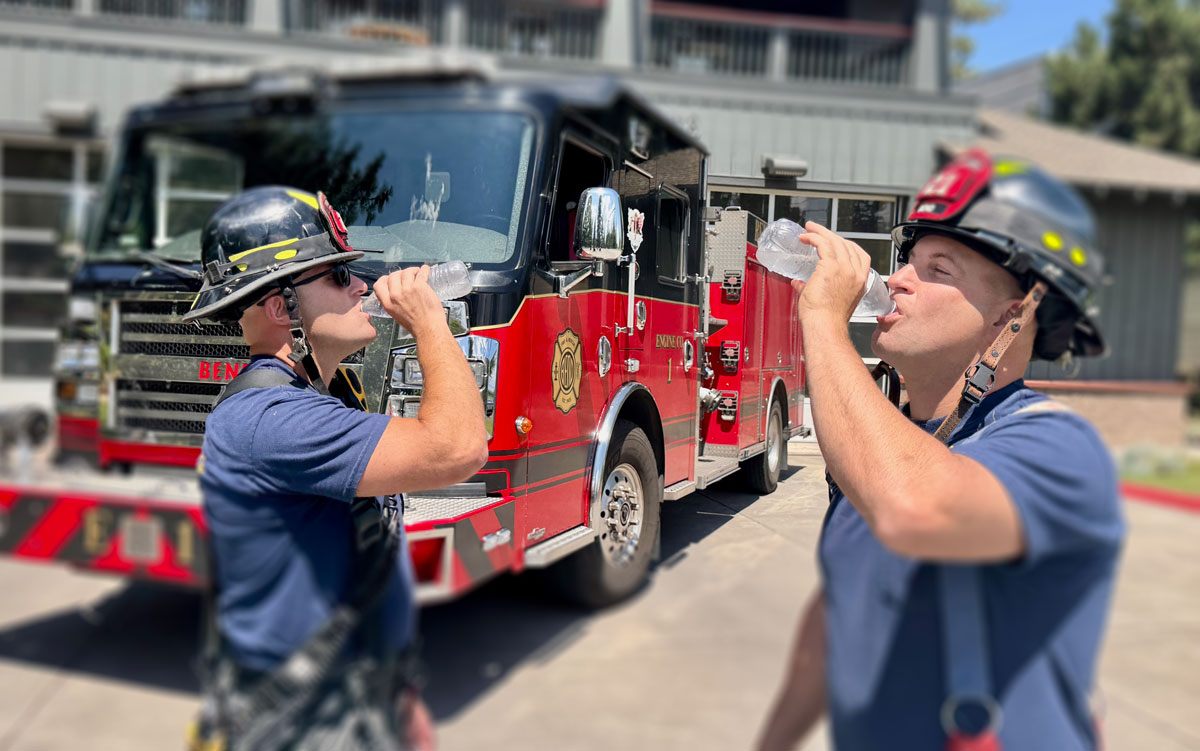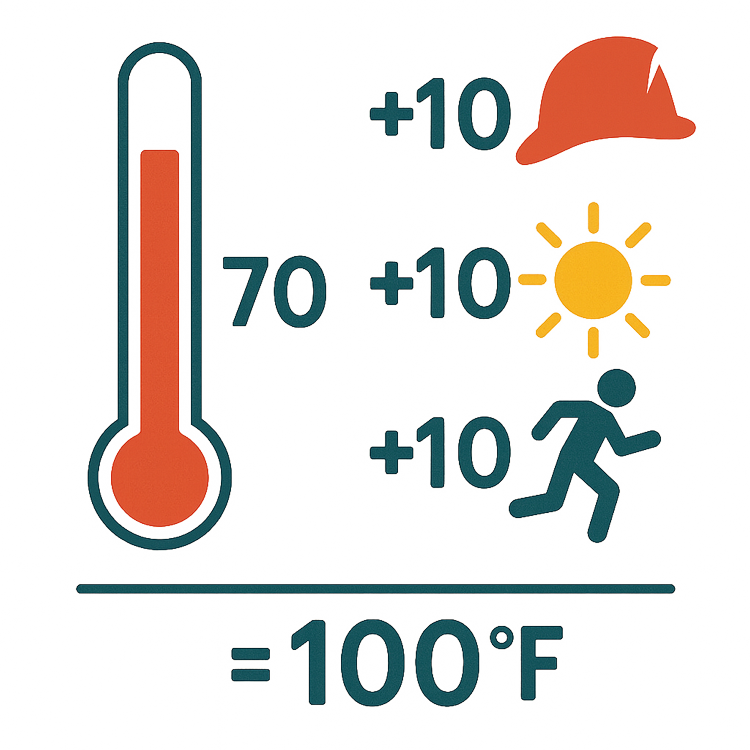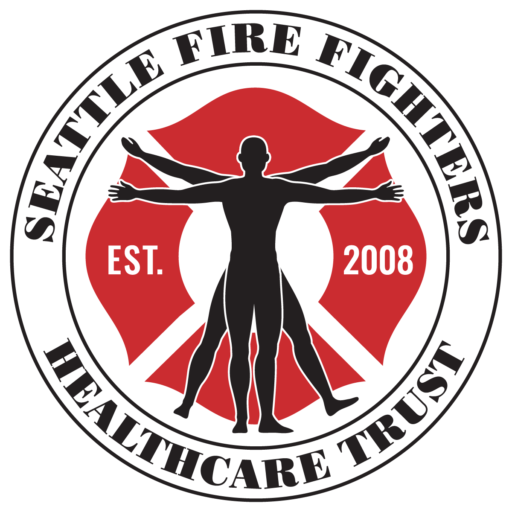
Hydration: It’s Fundamental to Your Health and Your Crew’s Success
Hydration on the Fireground: Why Every Sip Counts
When you’re fighting a fire, your gear, training, and teamwork keep you safe—but what about your water bottle? It might not seem as important as your personal protective equipment (PPE). Still, staying hydrated can make the difference between performing at your best and risking your health and safety. Fire fighters lose fluids faster than most athletes because the intense heat, their heavy equipment, and their sustained physical activity quickly deplete their hydration levels. Understanding how dehydration affects your body—and how to prevent it—can save your life. (Below is a list of the research reports and articles reviewed for this post, with links if you’d like to follow up on any of the topics covered.)
Sweating It Out: The Hidden Cost of Fighting Fires
Fire fighting is highly physically demanding. Just 30 to 45 minutes on the fireground can cause fluid losses of up to 50 to 70 ounces—much more than what typical athletes lose during training. Your protective gear, while crucial for safety, traps heat and sweat, greatly increasing your risk of dehydration.
Research shows that fire fighters often lose more than 2% of their body weight from sweat during a single response. This seemingly small loss can have significant health consequences. Dehydration raises the risk of cardiac events and strokes by causing a faster heart rate and higher demands on the heart. It also thickens the blood, which reduces blood flow, increases blood pressure, and makes blood clots more likely to form. These systemic changes can occur in just 30 to 40 minutes of active fire fighting. Nearly half of all fire fighter deaths on duty are caused by heart issues, highlighting the importance of staying hydrated.
Beyond physical exhaustion, dehydration can impair cognitive functions like decision-making, reaction time, and situational awareness—skills vital to fire fighting operations. Even mild dehydration diminishes strength, endurance, and alertness, making tasks harder and significantly increasing the risks to you and your crew. Heat illness is another critical concern. Without proper hydration, your body can’t regulate temperature effectively, increasing your risk of heat exhaustion or even heat stroke.
The safety and performance of the entire team require each fire fighter to stay well hydrated.
Stay Ready: Start Hydrated
Hydration starts well before you get on the fireground. Alarmingly, studies indicate that 80–90% of fire fighters show up on shift already dehydrated. Daily hydration is essential. The Mayo Clinic recommends approximately 125 ounces per day for men and 92 ounces per day for women. Begin each morning with at least 16 ounces of water and include electrolyte-rich snacks in your routine.
A simple self-check is to examine your urine color: a light yellow color indicates that you’re well-hydrated. Building a daily hydration habit strengthens your resilience before you’re facing the intense heat of a fire.
Hydrating Under Fire
During active fire suppression, ensure you consume at least one quart (approximately 32 ounces) of fluid every hour. For structural fire fighting—where your gear is heavier and the heat is more intense—you may need to drink more frequently, even before the event.
Water alone isn’t always sufficient. Your body also loses essential electrolytes, such as sodium and potassium. Combining your water intake with carbohydrate and electrolyte drinks can significantly enhance your hydration by replenishing lost salts and maintaining your energy level.
Recovery Matters: Hydrate After the Fire
After an intense response, rehydration becomes essential. Quickly evaluate fluid loss by comparing your pre- and post-fire body weight. For every pound lost, aim to drink at least 16–24 ounces of fluids.
The National Fire Protection Association (NFPA) standards emphasize the importance of rehabilitation zones. These areas should provide shade, fans, rest, medical monitoring, and ample fluids to facilitate a swift recovery. Rehydrating quickly helps restore your body’s balance, lessens ongoing cardiovascular stress, and prepares you for the next call.
Building Long-Term Hydration Habits
Hydration isn’t just about putting out fires; it’s about building lifelong habits that protect your health. Reduce dehydrating substances like alcohol and caffeine, and use hydration-tracking smartphone apps, such as Waterllama (iOS) or WaterMinder (iOS and Android), to customize and sustain your hydration routine.
Building a team culture that stresses the importance of hydration reinforces its value. When everyone prioritizes hydration, accountability increases, making each fire fighter safer and more effective.
Every Drop Counts
Proper hydration isn’t optional—it’s essential. Recognizing hydration as a key part of fire fighting performance helps protect you and boosts your crew’s effectiveness. Stay proactive, stay hydrated, and ensure every sip supports your health, safety, and your team’s success.
This article was written with the help of retired Seattle Fire Fighter Terry Taylor, who authored the “Safety Break” column in Local 27 newspaper, “The Third Rail,” from 1995 to 2007. The content was also reviewed by the Station 2 Clinic.
Terry’s Tip: It’s Hotter Than You Think!
“When you’re actively fighting a fire, you’re in a microclimate. Body heat, sunlight, and humidity all contribute to increasing the temperature inside your gear. Here’s a simple way to estimate the actual temperature you’re working in: take the outdoor temperature (for example, 70 degrees Fahrenheit), then add ten degrees for your protective gear, another ten degrees if you’re in direct sunlight, and an additional ten degrees if you’re doing moderate to intense physical activity. Working on that 70-degree day now feels like you’re in about 100 degrees Fahrenheit, which can lead to fatigue, heat cramps, heat exhaustion, or worse. Dehydration can also lead to impaired decision-making in stressful situations, such as fighting a fire. The key takeaway is simple: stay hydrated to stay safe.”
Terry Taylor, Retired Fire Fighter, Local 27

Additional Reading
The following research reports provide detailed in on the impacts of dehydration on fire fighters:
- “Hydration Considerations to Improve the Physical Performance and Health of Fire Fighters,” Angelia M Holland-Winkler and Blake K Hamil. National Library of Medicine, 2024.
- “The Impact of Occupational Tasks on Fire Fighter Hydration During a Live Structural Fire,” Adam Walker, Rodney Pope, Ben Schram, Richard Gorey, and Robin Orr. MDPI, 2019.
The following articles are also valuable resources for further reading on this subject:
- “National Wildfire Coordinating Group (NWCG) Hydration Guidelines.” National Wildfire Coordinating Group.
- “Hydration Strategies for Fire Fighters,” Joe Domitrovich and Brian Sharkey. United States Forest Service Department of Agriculture, 2008.
- “Fire Rescue Fitness: Hydration Advice for Fire Fighters,”
- “Hydration on Shift,” Mosier Data. Palm Beach Gardens Fire Rescue Health & Wellness, 2024.
